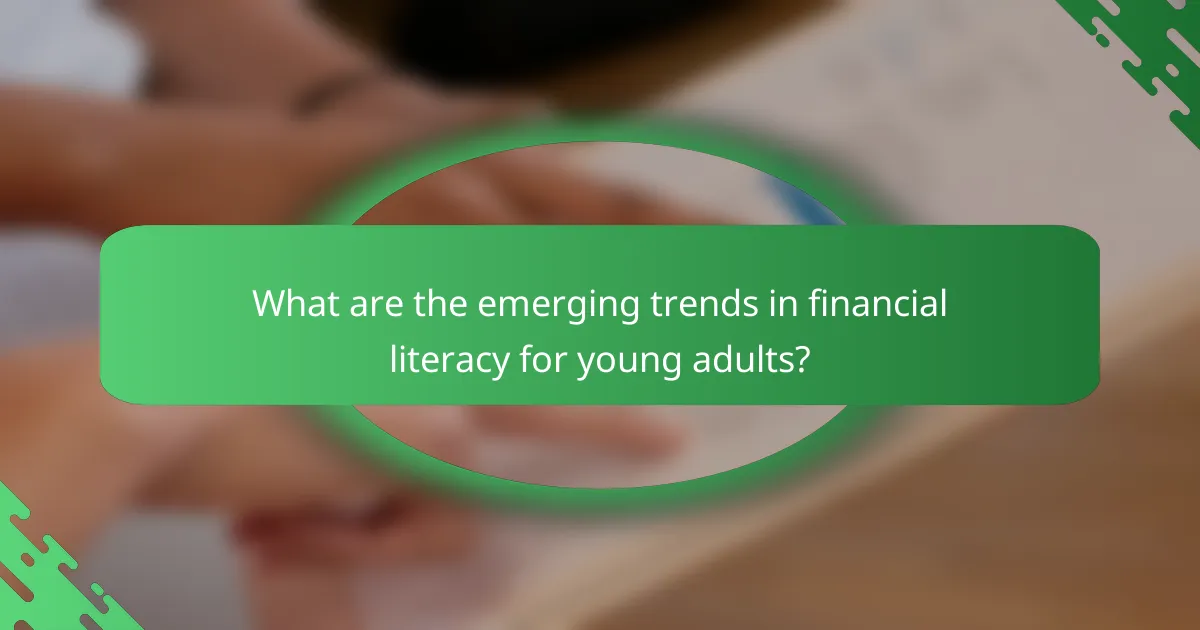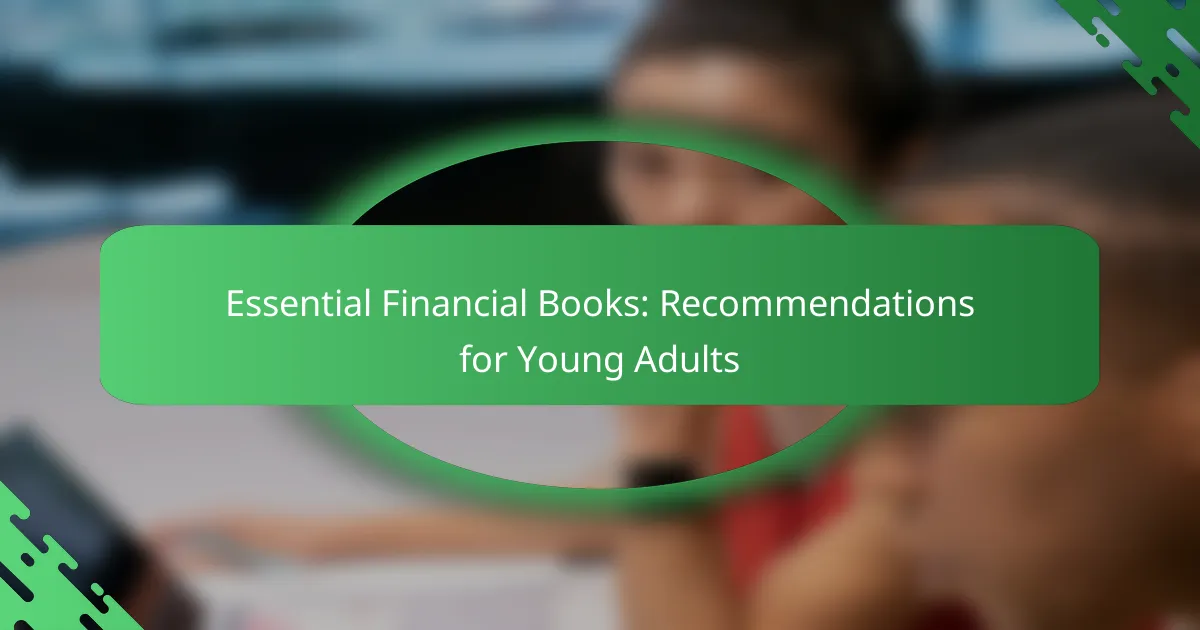For young adults in Australia, exploring essential financial books can be a transformative step towards mastering money management. These resources offer practical advice on budgeting, investing, and achieving financial independence, tailored to the unique challenges faced in the Australian context. By focusing on credible authors and relevant content, young readers can equip themselves with the knowledge needed for informed financial decision-making and long-term stability.

What are the best financial books for young adults in Australia?
For young adults in Australia, several financial books stand out for their practical advice and relatable content. These books cover essential topics such as budgeting, investing, and financial independence, making them valuable resources for anyone looking to improve their financial literacy.
The Barefoot Investor by Scott Pape
The Barefoot Investor is a popular guide that simplifies personal finance for Australians. Scott Pape offers a straightforward approach to budgeting, saving, and investing, emphasizing the importance of financial security and independence.
Key strategies include setting up a “barefoot” bank account structure, which helps manage expenses and savings effectively. Pape’s relatable anecdotes and actionable steps make it easy for young adults to implement his advice.
Rich Dad Poor Dad by Robert Kiyosaki
Rich Dad Poor Dad presents a contrasting perspective on wealth and financial education through the experiences of Kiyosaki’s two father figures. The book emphasizes the importance of financial literacy, investing in assets, and understanding the difference between liabilities and assets.
Young adults can benefit from Kiyosaki’s insights on entrepreneurship and the mindset needed to achieve financial success. The lessons encourage readers to think critically about money and consider alternative paths to wealth beyond traditional employment.
The Total Money Makeover by Dave Ramsey
Dave Ramsey’s The Total Money Makeover provides a step-by-step plan for achieving financial health. Ramsey outlines a series of baby steps that guide readers through budgeting, debt elimination, and building an emergency fund.
His no-nonsense approach emphasizes discipline and accountability, making it suitable for young adults eager to take control of their finances. Ramsey’s methods are practical, with real-life examples illustrating how to achieve financial goals over time.
Money Smart by the Australian Securities and Investments Commission
Money Smart is an initiative by the Australian Securities and Investments Commission (ASIC) that offers free resources for financial education. The platform provides tools and information tailored to young adults, covering topics like budgeting, saving, and investing.
Utilizing interactive tools and calculators, Money Smart helps users understand their financial situation and make informed decisions. It’s an excellent starting point for young Australians looking to enhance their financial knowledge and skills.

How can financial books benefit young adults?
Financial books can significantly enhance young adults’ understanding of money management, investment, and budgeting. By providing essential knowledge and practical strategies, these resources empower individuals to make informed financial decisions that can lead to long-term stability and growth.
Improved financial literacy
Improved financial literacy is crucial for young adults as it lays the foundation for sound financial decisions. Reading financial books helps individuals understand key concepts such as budgeting, saving, and credit management. This knowledge is essential for navigating everyday financial challenges.
For instance, a book that explains the importance of credit scores can help young adults grasp how their financial behaviors impact their borrowing potential. Understanding terms like interest rates and compound interest can also lead to smarter choices regarding loans and savings accounts.
Better money management skills
Better money management skills are developed through practical guidance found in financial literature. Books often provide actionable tips on creating budgets, tracking expenses, and setting financial goals. These skills are vital for maintaining financial health and avoiding debt.
Young adults can benefit from using budgeting methods outlined in these books, such as the 50/30/20 rule, which suggests allocating 50% of income to needs, 30% to wants, and 20% to savings. This simple framework can help individuals prioritize their spending and savings effectively.
Informed investment decisions
Informed investment decisions are a key benefit of reading financial books, as they equip young adults with the knowledge needed to navigate the investment landscape. Understanding different investment vehicles, such as stocks, bonds, and mutual funds, is essential for building wealth over time.
Books that cover investment strategies can help young adults assess their risk tolerance and develop a diversified portfolio. For example, learning about index funds and their low fees can encourage individuals to consider passive investing as a viable option for long-term growth.

What criteria should young adults consider when choosing financial books?
Young adults should focus on the credibility of the author, the relevance of the content to the Australian financial landscape, and the practical application of the concepts presented. These criteria ensure that the books are trustworthy, applicable, and beneficial for managing personal finances effectively.
Author credibility
When selecting financial books, consider the author’s background and expertise in finance. Look for authors with relevant qualifications, such as degrees in finance or economics, and those who have experience in the industry. Books written by recognized financial experts or practitioners often provide more reliable insights.
Additionally, check for reviews and recommendations from reputable sources or financial professionals. This can help gauge the author’s reputation and the book’s overall trustworthiness.
Relevance to Australian financial context
It’s crucial that the financial books address the unique aspects of the Australian financial system, including taxation, investment options, and superannuation. Books that focus on local regulations and economic conditions will be more applicable to young adults living in Australia.
Look for resources that incorporate Australian currency (AUD) and discuss local financial institutions, as this will make the information more relatable and actionable. For instance, understanding the Australian Taxation Office’s guidelines can significantly impact personal finance decisions.
Practical application of concepts
Choose books that not only explain financial theories but also provide actionable steps and real-life examples. Practical application helps young adults implement what they learn, making the concepts more tangible and easier to understand.
Consider books that include exercises, worksheets, or case studies that encourage readers to apply the concepts to their own financial situations. This hands-on approach can enhance learning and retention, ultimately leading to better financial management skills.

What are some popular financial book recommendations for Australian young adults?
For Australian young adults looking to enhance their financial literacy, several books stand out as essential reads. These recommendations provide practical insights into personal finance, investing, and wealth-building strategies tailored to the unique Australian context.
The Wealthy Gardener by John Soforic
This book combines storytelling with financial wisdom, making it accessible for young adults. Soforic shares lessons on wealth accumulation through the metaphor of gardening, emphasizing patience and nurturing one’s financial growth over time.
Readers will find actionable advice on budgeting, saving, and investing, which can be applied to their daily lives. The book encourages a mindset shift towards long-term financial health rather than immediate gratification.
Invested by Danielle Town and Phil Town
In “Invested,” Danielle and Phil Town guide readers through the fundamentals of investing, focusing on building a solid foundation for financial independence. The book demystifies the stock market and encourages young adults to take control of their investment strategies.
With practical exercises and a clear framework, readers learn how to evaluate companies and make informed investment decisions. This book is particularly useful for those new to investing and seeking to grow their wealth over time.
Financial Freedom by Grant Sabatier
Grant Sabatier’s “Financial Freedom” is a comprehensive guide for young adults aiming to achieve financial independence. The book outlines various strategies to increase income, reduce expenses, and invest wisely to reach financial goals.
Sabatier shares his personal journey from being broke to achieving financial freedom in just a few years, offering relatable insights and practical steps. This book is ideal for those who want to develop a proactive approach to their finances and create a life of abundance.

How do these financial books compare?
These financial books offer varying perspectives and strategies for managing money, making them suitable for different learning styles and financial goals. Understanding their key concepts, target audiences, and practical advice can help young adults choose the right resources for their financial education.
Comparison of key concepts
Each financial book presents unique concepts that cater to different aspects of personal finance. For instance, some focus on budgeting techniques, while others emphasize investing strategies or debt management. Recognizing these core ideas can help readers align their learning with their financial objectives.
Books like “The Total Money Makeover” by Dave Ramsey prioritize debt elimination through a structured plan, while “Rich Dad Poor Dad” by Robert Kiyosaki encourages a mindset shift towards wealth-building through investments. This diversity in concepts allows readers to pick what resonates most with their current financial situation.
Target audience differences
The target audience for these financial books varies significantly, affecting their tone and complexity. Some books are tailored for beginners, using straightforward language and basic concepts, while others are designed for those with some financial knowledge, offering more advanced strategies and jargon.
Practicality of advice
The practicality of advice in these financial books can vary, impacting how easily readers can implement the strategies. Some books provide actionable steps and checklists, making it easier for young adults to apply the concepts in real life. Others may offer theoretical insights that require further research to execute effectively.
For instance, “I Will Teach You to Be Rich” by Ramit Sethi includes specific, actionable steps for managing finances, while “Your Money or Your Life” by Vicki Robin focuses on a broader philosophy of money management. Young adults should consider how practical the advice is when choosing which book to follow, ensuring they can realistically apply the lessons learned.

What are the emerging trends in financial literacy for young adults?
Emerging trends in financial literacy for young adults focus on adapting to technological advancements and changing economic landscapes. Key areas include digital finance, sustainability in investing, and the importance of mental health in financial decision-making.
Increased focus on digital finance
The rise of digital finance has transformed how young adults manage their money. With the proliferation of mobile banking apps, cryptocurrencies, and online investment platforms, financial transactions are now more accessible and convenient than ever.
Young adults should consider the security and fees associated with digital finance tools. For instance, while many apps offer free transactions, some may charge for premium features or have hidden fees. It’s crucial to read the terms and conditions before committing to any platform.
Additionally, understanding the basics of cryptocurrencies can be beneficial. While investing in digital currencies can be volatile, platforms like Coinbase or Binance provide educational resources for beginners. Young adults should start small and diversify their investments to mitigate risks.
